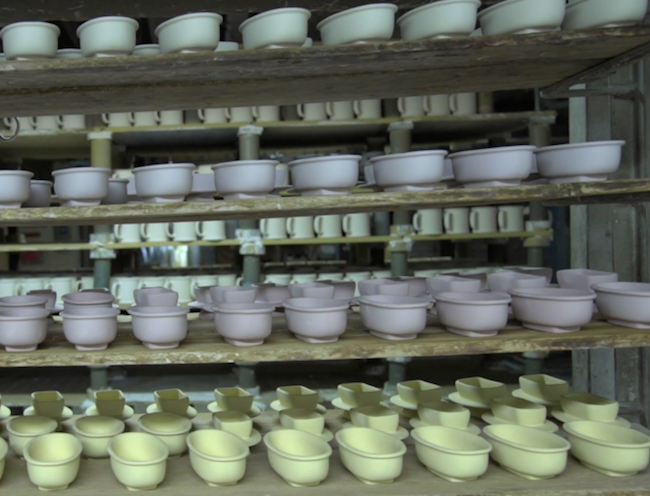One of my earliest experiences with ceramics was when I was a kid and my mother would take me to East Liverpool, Ohio to shop for factory outlet Fiesta dinnerware. It was an annual sale of tableware that had slight defects. My brothers and I would stand inside that hot concrete building for hours while mom scavenged through towering stacks of dishes for something that was just the right shade of dark goldenrod yellow for the kitchen. East Liverpool was a city known for its ceramics manufacturing, so much so that their high school mascot, to this day, is an angry kiln wearing a football uniform.
Unfortunately, the story of East Liverpool follows a formula similar to many places in Ohio: it used to make n but then the industry around n in the United States dried up and the city never fully recovered (substitute for n where n is the name of any industry that once paid people to make a product).
So it was a shock when Garth sent me this video for a writeup and I saw the familiar sight of a barge going down the Ohio River. This short video about “The Butter Basin” (now called the Butter Bay) was shot by Chad Case Photo & Video and it exists as a ray of sunshine against all of the pitch black economic cynicism that has blanketed my soul for the last couple of decades.
It’s such a simple story, drawn whole from the Gospel of American Entrepreneurialism: a guy in Idaho noticed that his family’s butter dish could be better designed. If it’s left in the fridge, you have to chisel out chunks of butter with a knife and the butter won’t spread well. If the dish is left out at room temperature, the butter gets melted and gross. What if there was a butter dish that hugged the butter so it could be stored at room temperature without melting everywhere? Brilliant! Let’s pay a guy to design this!
The designer finishes a prototype of the dish and the businessman— bless his heart— wants to make this product in the United States. He turns to the people at American Mug and Stein in East Liverpool. The owner, who is one of two pottery businesses left in that city, takes on the project. With the commission he’s able to pay for four full-time workers. They interview an employee who talks about the deep feeling of satisfaction he gets from creating a well-made dish!
Maybe my exasperation needs some context. If this were an old industrial film from the 1950s, you’d assume someone was feeding you a line about the wonders of capitalism. If you saw this as an educational segment on Mr. Rogers, you’d assume it was factual, but that it was simplifying things for children. The strangest part about this video is that I believe it is honest; I believe all of its subjects are honest. In achieving this it reaches for a kind of sincerity that is in short supply. It’s a charming parable about how industry should function. I never knew an ad for a ceramic butter dish could move me to such places, but I won’t sneer at it.
Bill Rodgers is the Managing Editor of cfile.daily.
Love contemporary ceramic art + design? Let us know in the comments.

A very misleading video as to the origin of this butter keeper. The original concept and designs are from the late 19th century and are generally know as a “French Butter Dish.” This video gives the impression that it is a new invention…Not true.
If you take a look at the Butter Bay (formerly known as Butter Basin) website http://www.thebutterbay.com you will notice that the product is repeatedly referred to as “inspired by the French Butter Crock” or “an improvement on the centuries-old French Butter Crock.” The video itself also doesn’t claim that the French Butter Crock is a new invention. Rather it highlights the innovations made to the original idea and discusses that the inventor of this product was dissatisfied with traditional butter crocks. This video is about the Butter Bay specifically as well as the process of the product being handmade in America, not the history of butter crocks in general.